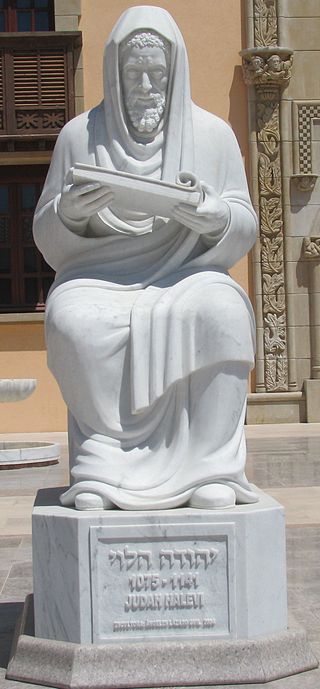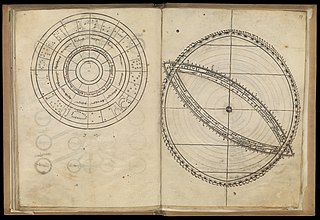
Isaac ibn Sid was a Spanish-Jewish astronomer who flourished at the Toledo School of Translators in the second half of the thirteenth century.

Isaac ibn Sid was a Spanish-Jewish astronomer who flourished at the Toledo School of Translators in the second half of the thirteenth century.
Isaac ibn Sid took a leading part in the compilation of the Alfonsine Tables. Isaac Israeli (ib.) states that he saw recorded in Isaac ibn Sid's own handwriting three observations of moon eclipses made by him at the order of Alfonso. In official documents (De Castro, "Bibliotheca," i. 184b) Isaac ibn Sid is termed by Alfonso "our learned Rabbi Çag."
In 1277, Isaac translated from the Arabic a work on the quadrant. His name is also connected with the invention of various instruments (De Castro, l.c. i. 144a, 156a, 157).

Judah Halevi was a Spanish Jewish physician, poet and philosopher. He was born in Spain, either in Toledo or Tudela, in 1075 or 1086, and died shortly after arriving in the Holy Land in 1141, at that point the Crusader Kingdom of Jerusalem.
The golden age of Jewish culture in Spain, which coincided with the Middle Ages in Europe, was a period of Muslim rule during which, intermittently, Jews were generally accepted in society and Jewish religious, cultural, and economic life flourished.

Abū Isḥāq Ibrāhīm ibn Yaḥyā al-Naqqāsh al-Zarqālī al-Tujibi ; also known as Al-Zarkali or Ibn Zarqala (1029–1100), was an Arab maker of astronomical instruments and an astrologer from the western part of the Islamic world.
Ibn Tibbon, is a family of Jewish rabbis and translators that lived principally in Provence in the 12th and 13th centuries.
Jacob ben Machir ibn Tibbon, of the Ibn Tibbon family, also known as Prophatius, was a Jewish astronomer; born, probably at Marseilles, about 1236; died at Montpellier about 1304. He was a grandson of Samuel ben Judah ibn Tibbon. His Provençal name was Don Profiat Tibbon; the Latin writers called him Profatius Judæus. Jacob occupies a considerable place in the history of astronomy in the Middle Ages. His works, translated into Latin, were quoted by Copernicus, Reinhold, and Clavius. He was also highly reputed as a physician, and, according to Jean Astruc, Ibn Tibbon was regent of the faculty of medicine of Montpellier.

The Toledan Tables, or Tables of Toledo, were astronomical tables which were used to predict the movements of the Sun, Moon and planets relative to the fixed stars. They were a collection of mathematic tables that describe different aspects of the cosmos including prediction of calendar dates, times of cosmic events, and cosmic motion.

Isaac Israeli ben Solomon, also known as Isaac Israeli the Elder and Isaac Judaeus, was one of the foremost Jewish physicians and philosophers living in the Arab world of his time. He is regarded as the father of medieval Jewish Neoplatonism. His works, all written in Arabic and subsequently translated into Hebrew, Latin and Spanish, entered the medical curriculum of the early thirteenth-century universities in Medieval Europe and remained popular throughout the Middle Ages.

The Alfonsine Tables, sometimes spelled Alphonsine Tables, provided data for computing the position of the Sun, Moon and planets relative to the fixed stars.

Latin translations of the 12th century were spurred by a major search by European scholars for new learning unavailable in western Europe at the time; their search led them to areas of southern Europe, particularly in central Spain and Sicily, which recently had come under Christian rule following their reconquest in the late 11th century. These areas had been under Muslim rule for a considerable time, and still had substantial Arabic-speaking populations to support their search. The combination of this accumulated knowledge and the substantial numbers of Arabic-speaking scholars there made these areas intellectually attractive, as well as culturally and politically accessible to Latin scholars. A typical story is that of Gerard of Cremona, who is said to have made his way to Toledo, well after its reconquest by Christians in 1085, because he
arrived at a knowledge of each part of [philosophy] according to the study of the Latins, nevertheless, because of his love for the Almagest, which he did not find at all amongst the Latins, he made his way to Toledo, where seeing an abundance of books in Arabic on every subject, and pitying the poverty he had experienced among the Latins concerning these subjects, out of his desire to translate he thoroughly learnt the Arabic language....

The Toledo School of Translators is the group of scholars who worked together in the city of Toledo during the 12th and 13th centuries, to translate many of the Judeo-Islamic philosophies and scientific works from Classical Arabic into Latin.
Samuel ibn Seneh Zarza was a Spanish philosopher who lived in Palencia in the second half of the 14th century. According to Leopold Zunz, his surname is derived from the Spanish town Zarza, and is accordingly synonymous with the Hebrew "seneh." Of his life no details are known, for while in his notes on the Sefer ha-Yuḥasin Samuel Shullam states that Zarza was burned at the stake by the tribunal of Valencia on the denunciation of Isaac Campanton, who accused him of denying the creation of the world, historians have proved this assertion a mere legend. Although a comparatively unimportant writer, if his two works may serve as a criterion, Zarza ranked high in the estimation of his contemporaries, so that the poet Solomon Reubeni of Barcelona and the astronomer Isaac ibn Al-Ḥadib composed poems in his honor.
Qusta ibn Luqa, also known as Costa ben Luca or Constabulus (820–912) was a Syrian Melkite Christian physician, philosopher, astronomer, mathematician and translator. He was born in Baalbek. Travelling to parts of the Byzantine Empire, he brought back Greek texts and translated them into Arabic.
Jehiel of Pisa was a philanthropist and scholar of Pisa.
Shem-Tob ben Isaac Shaprut of Tudela was a Spanish Jewish philosopher, physician, and polemicist. He is often confused with the physician Shem-Tob ben Isaac of Tortosa, who lived earlier. He may also be confused with another Ibn Shaprut, Hasdai Ibn Shaprut, who corresponded with the king of the Khazars in the 900's.
Shem-Ṭob ben Isaac of Tortosa was a Provençal rabbi and physician.
Ṣāʿid al-Andalusī, in full Abū al-Qāsim Ṣāʿid ibn Abū al-Walīd Aḥmad ibn Abd al-Raḥmān ibn Muḥammad ibn Ṣāʿid ibn ʿUthmān al-Taghlibi al-Qūrtūbi, was an Arab qadi of Toledo in Muslim Spain, who wrote on the history of science, philosophy and thought. He was a mathematician and scientist with a special interest in astronomy and compiled a famous biographic encyclopedia of science that quickly became popular in the empire and the Islamic East.
Rabbi Samuel ben Isaac de Uçeda was a Jewish commentator and preacher. Born at Safed in the first quarter of the sixteenth century, his name, Uçeda, originally was derived from the town Uceda in the archbishopric of Toledo. He was a pupil of Isaac Luria and Hayyim Vital, with whom he studied kabbalah, and became rabbi and preacher in Safed and, later, in Constantinople.
Yehuda ben Moshe ha-Kohen lived during the 13th century and became the personal physician of King Alfonso X of Castile.
Abraham of Toledo, also known as Abraham Alfaquín and Abraham ibn Waqar, was an Iberian Jewish physician and translator of the Toledo School of Translators.
Alfonso Buenhombre was a Dominican missionary and polemicist.
![]() This article incorporates text from a publication now in the public domain : Singer, Isidore; et al., eds. (1901–1906). The Jewish Encyclopedia . New York: Funk & Wagnalls.
This article incorporates text from a publication now in the public domain : Singer, Isidore; et al., eds. (1901–1906). The Jewish Encyclopedia . New York: Funk & Wagnalls.{{cite encyclopedia}}: Missing or empty |title= (help)